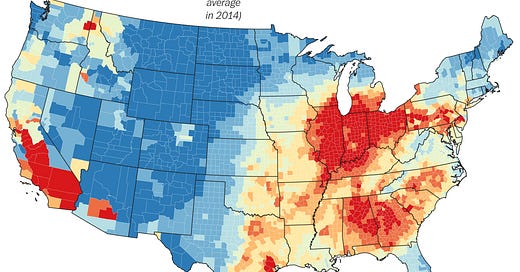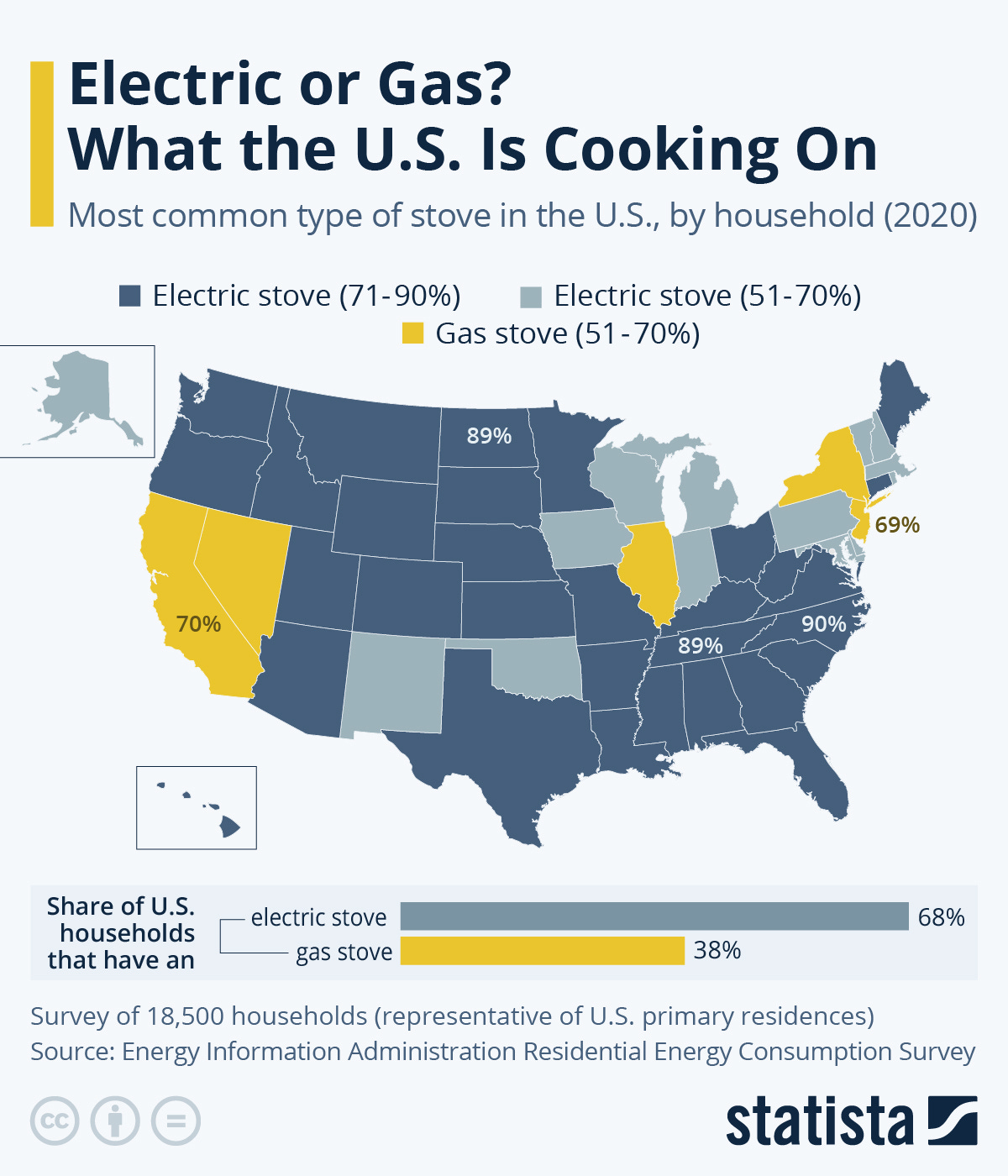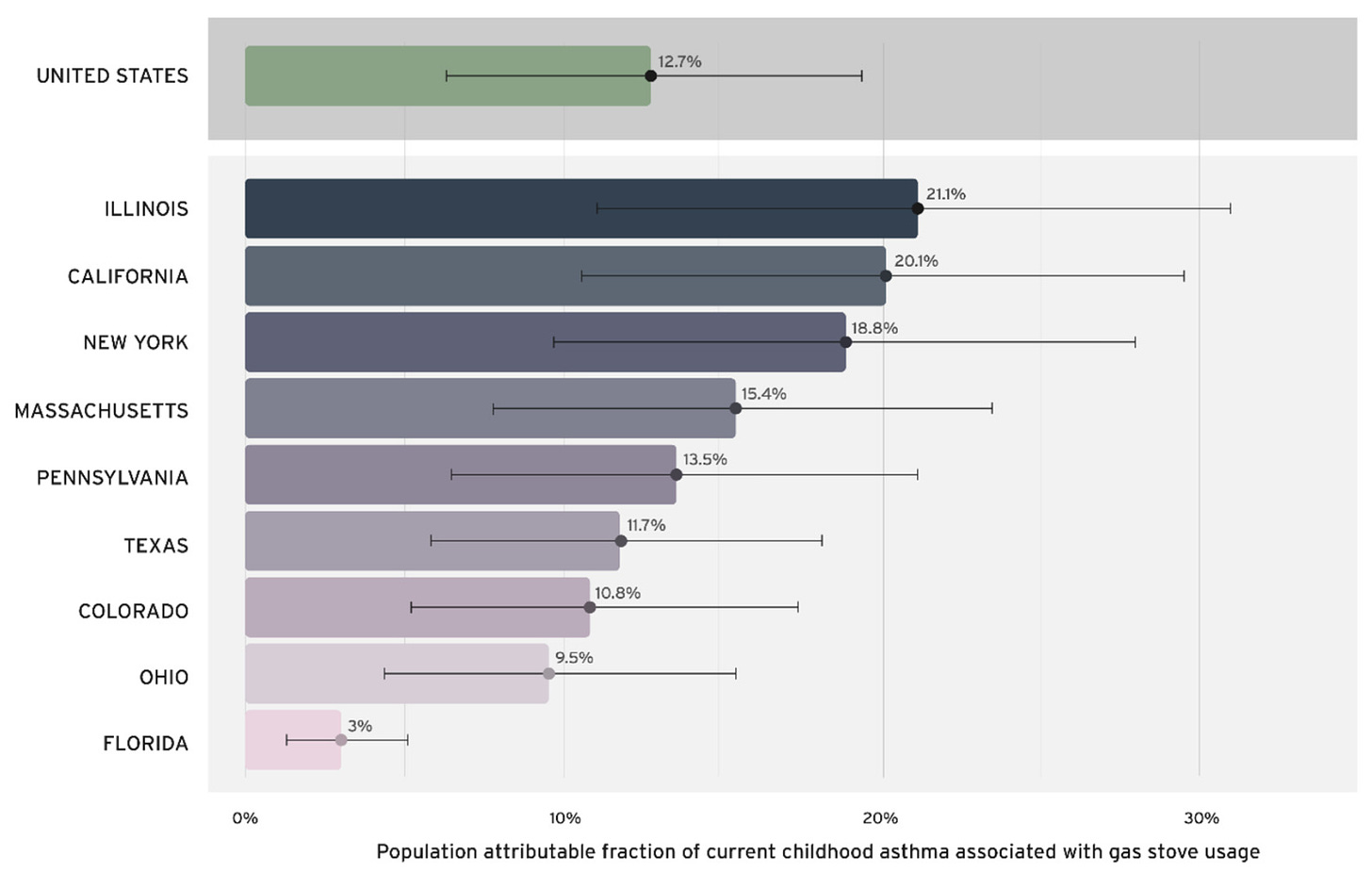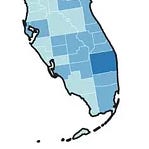The Gas Stove Asthma Lie
"Gas Stoves Cause Asthma" junk science ignores the biggest asthma confounder.
This week’s Culture War Current Thing is one of the most absurd ones I’ve seen in years. Gas stoves? Really?
At HWFO, we’ve built a brand around exposing the absurdities underlying culture war episodes, particularly when it comes to bad science, and the science behind “gas stoves cause asthma” is some of the dumbest I have ever seen. Let’s go through it.
Asthma and Pollution
One of the leading associations between childhood asthma and the environment is exposure to fine particulate matter. This result has been confirmed repeatedly by sound science. And fine particulate matter is not evenly distributed in the country. Here’s a county by county map of PM2.5, which is how fine particulate matter is measured.
Gas stove use is also not evenly distributed across the country. In fact, the studies being used to link gas stove use to childhood asthma are entirely dependent on this fact to draw their conclusions, since they did no actual research. They were merely establishing bivariate correlations without accounting for any confounders, as we will see in the next section. It’s difficult to identify ratio of gas stove use across the country, but this is the best information I could find with a quick search.
The five states with the most gas stove use in the country are California, Indiana, New York, Nevada, and New Jersey. The biggest cities (600k+ population) in those states are:
Los Angeles
San Diego
San Jose
San Francisco
Indianapolis
NYC
Hempstead Town
Las Vegas
Newark (not actually 600k+ but threw it in)
Here’s where those cities show up in the particulate pollution map, highlighted with green circles:
The Asthma Freakoutery Study
The science for “gas stoves cause asthma” being referenced by outlets such as Wired can be found here:
https://www.mdpi.com/1660-4601/20/1/75
Let’s highlight some elements of this study.
Abstract
Indoor gas stove use for cooking is associated with an increased risk of current asthma among children and is prevalent in 35% of households in the United States (US). The population-level implications of gas cooking are largely unrecognized. We quantified the population attributable fraction (PAF) for gas stove use and current childhood asthma in the US. Effect sizes previously reported by meta-analyses for current asthma (Odds Ratio = 1.34, 95% Confidence Interval (CI) = 1.12–1.57) were utilized in the PAF estimations.
So far so good.
The proportion of children (<18 years old) exposed to gas stoves was obtained from the American Housing Survey for the US, and states with available data (n = 9).
They only had nine states for which they had data, and they did not do the analysis on a county-by-county basis. The abstract rounds up as follows:
We found that 12.7% (95% CI = 6.3–19.3%) of current childhood asthma in the US is attributable to gas stove use. The proportion of childhood asthma that could be theoretically prevented if gas stove use was not present (e.g., state-specific PAFs) varied by state (Illinois = 21.1%; California = 20.1%; New York = 18.8%; Massachusetts = 15.4%; Pennsylvania = 13.5%). Our results quantify the US public health burden attributed to gas stove use and childhood asthma. Further research is needed to quantify the burden experienced at the county levels, as well as the impacts of implementing mitigation strategies through intervention studies.
Their mindbogglingly simple methodology completely ignores confounders:
First, we sought to update the effect-size estimates by identifying peer-reviewed manuscripts published subsequent to the most recent meta-analysis [1]. We searched PubMed using keywords: “gas cooking and children” OR “gas appliance and children” OR “unvented and children” OR “gas heating and children” OR “gas heater and children”. After including only manuscripts of human studies published in English since 4 January 2013, 357 studies remained for possible inclusion. The title review identified 27 manuscripts as potentially pertinent. Full manuscripts (n = 27) were independently reviewed by co-authors; none reported new associations between gas stove use and childhood asthma specifically in North America or Europe. As a result, effect sizes previously reported for current asthma in North America and Europe combined (weighted by inverse variance; Nstudies = 10; Odds Ratio (OR) = 1.34, 95% Confidence Interval (CI) = 1.12–1.57) were utilized in the PAF estimations [1]. The combined effect size was based on a North America-specific effect size (Nstudies = 3; OR = 1.36, 95% CI = 0.76–2.43) and Europe-specific effect size (Nstudies = 7; OR = 1.34, 95% CI = 1.13–1.60), as reported in a previously published meta-analysis [1]. We combined effect sizes for North America and Europe given the similarities in housing characteristics and gas-stove usage patterns across these geographies. We estimated the proportion of children (<18 years old) exposed to gas stoves in the US and in certain states using the American Housing Survey (AHS) [2]. The AHS is a nationally representative survey of households used to characterize the residential housing stock of the US. Each year, a subset of states is oversampled, allowing for precise estimates of housing characteristics for these states. In the most recent iteration of the survey in 2019, nine states were oversampled, allowing us to estimate PAFs at the national level and for these nine states.
PAFs were estimated using a previously published approach [4]. The approach aimed to quantify our uncertainty regarding the PAF point estimates, given that the inputs to the calculation are based on samples of the population. First, we used the summary statistics of the North America and Europe combined odds ratio described above to generate a distribution of effect sizes. Similarly, we used the summary statistics of the proportion of children exposed to gas cooking to generate distributions of proportions nationally and for each state for which we have data. We then drew a random value from each of these distributions to calculate the PAF according to the following equation:
where p is the proportion of households with children exposed to gas stoves and RR is the relative risk of developing asthma given exposure to gas stoves. Note that we used the combined North America and Europe odds ratio for the relative risk in this equation, as childhood asthma in the US remains relatively rare, affecting 1 in 12 children [5]). We repeated this calculation 10,000 times to create distributions of PAFs nationally and for each state, using the same combined odds ratio for national- and state-level calculations We then took the mean of these distributions and calculated their 95% confidence intervals to estimate the PAF of current childhood asthma attributable to gas stove usage. All calculations were performed using the R programming language.
In case you didn’t understand that, they basically built a very complex way to cook up a bivariate correlation from data from nine US states. They probably could have gotten very similar results by simply plotting those nine states on a scatter diagram and slapping in a trendline. They took no confounders into account. They even stated so outright here in their discussion section:
…rests on the assumptions that (1) exposure to gas cooking among children is orthogonal to other risk factors such as exposure to tobacco smoke and…
They didn’t even mention air pollution as a potential confounder. It’s as if it never occurred to them.
This is their result:
Florida is at the bottom. What does the populated area of Florida look like on our particulate pollution map?
Illinois is at the top. Where do a disproportionate number of children live in Illinois?
California is second from the top. Where do a disproportionate number of kids live there?
Where do most of the children in New York live?
And so forth.
Confounders
We cannot know for sure whether this study’s conclusion is correct, or whether it might actually be stated thusly:
“People who cook with gas stoves are more likely to live in areas with higher particulate pollution than people who cook with electric stoves.”
This other conclusion checks out intuitively, because in order to have a gas stove you either have to live near enough to a city that you have a gas utility line in your street, or you must buy your propane on a truck and keep it in a tank beside your house. Most rural houses have electric stoves, and most rural houses have less particulate pollution, leading to less asthma.
The entire study could just be a geography proxy.
The only way anyone could differentiate between those two effects is to get gas stove utilization ratio, childhood asthma ratio, and particulate pollution ratio, on a county by county basis instead of state basis, and do a proper multivariate analysis on the data. Nobody has done that. This study certainly didn’t do that, and it’s lack-of-doing-that should have gotten it punted in peer review. Until someone does that, all this freakoutery about gas stoves can and should be completely ignored.















"Until someone does that, all this freakoutery about gas stoves can and should be completely ignored."
...Except it can't be ignored, because the enstupidiated in Congress are going to make law based upon flawed data. For the children, of course.
Oh, and the obvious unspoken part: the study was pushed by green energy electric stove advocates.
"A recent study that linked gas-burning stoves to childhood asthma cases was backed by two nonprofits that are pushing for Americans to adopt electric stoves.
The study, which states that the stoves account for about 12.7% of childhood asthma cases in the U.S., was partly funded by RMI, a group that seeks to “accelerate the clean energy transition,” and co-authored by Brady Seals, the manager of RMI’s Carbon-Free Buildings arm that aims to retrofit buildings with electric appliances. The study was also co-authored by Rewiring America (RA) Research Associate Talor Gruenwald, who previously worked on RMI’s Carbon-Free Buildings team; RA is a nonprofit that is “focused on electrifying everything” in communities across America, accordingto its website.
The authors of the study declared that there were no conflicts of interest associated with their research.
RMI, which used the study to promote stove electrification, has received millions in donations from Breakthrough Energy, a green energy investment firm founded by Bill Gates, as well as the Bezos Earth Fund and Bloomberg Philanthropies, according to the RMI 2022 donors report."
https://www.shorenewsnetwork.com/2023/01/13/electric-appliance-advocates-backed-study-driving-push-to-ban-gas-stoves/
SSDD, same old One World elitist socialists, still trying to destroy our world to build their own micro-utopia on your suffering.